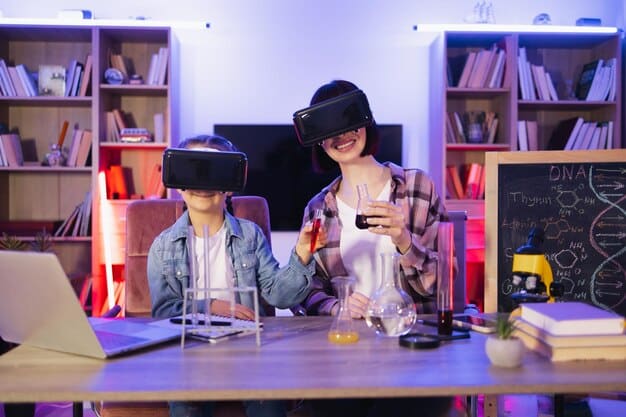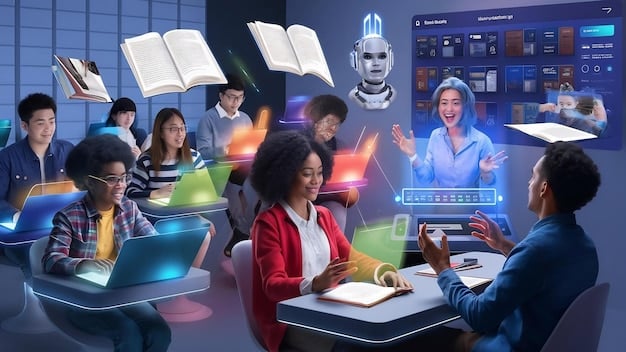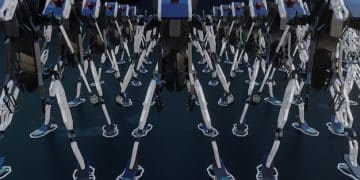Metaverse’s Impact on US Education: Learning Transformed by 2027

The metaverse is poised to revolutionize US education by 2027, transforming traditional learning into immersive, interactive, and personalized experiences that enhance student engagement and skill development across all levels.
In a rapidly evolving digital landscape, the confluence of technology and pedagogy is reaching an unprecedented inflection point. The concept of The Metaverse and US Education: Transforming Learning Experiences by 2027 is no longer a futuristic fantasy but a tangible horizon, promising to redefine how students learn, interact, and prepare for tomorrow’s world. This shift represents a profound paradigm change, moving beyond mere digital tools to establish truly immersive and interactive educational ecosystems.
The Metaverse: More Than Just Virtual Reality
The metaverse, often misunderstood as simply virtual reality (VR), is a persistent, shared, 3D virtual space built on open standards, allowing for avatars, digital objects, and social interaction. It encompasses not just VR, but also augmented reality (AR), mixed reality (MR), and the broader concept of digital twinning, where real-world objects and processes have digital counterparts. This rich environment offers a canvas for education that transcends physical limitations.
Defining the Educational Metaverse
For education, the metaverse implies a network of interconnected virtual worlds where learning can occur in highly interactive and experiential ways. It’s a space where students can meet, collaborate, participate in simulations, and engage with content that would be impossible or impractical in a traditional classroom. The underlying technologies, such as blockchain for digital assets and AI for personalized learning paths, provide foundational components for a robust educational infrastructure. This new frontier promises to foster a deeper understanding of complex subjects by allowing students to experience them directly.
The educational metaverse presents several key characteristics:
- Immersive Environments: Places where learners can explore historical events, conduct scientific experiments, or travel to remote locations without leaving their homes.
- Persistent Presence: Digital identities and learning progress can be maintained across different virtual platforms.
- Interactivity and Collaboration: Students and educators can interact in real-time, regardless of geographical location, fostering global collaboration.
- Personalized Learning Paths: AI within the metaverse can adapt content and challenges to individual student needs and learning styles.
Technological Foundations and Accessibility
The rapid advancement of VR/AR hardware, coupled with decreasing costs, is making immersive educational experiences more accessible. While high-end headsets are still relatively expensive, standalone devices are becoming more affordable, and mobile-based AR experiences are already widespread. Connectivity improvements, particularly with 5G networks, also ensure that these data-intensive environments can run smoothly, minimizing latency and enhancing the user experience. Addressing the digital divide remains crucial to ensure equitable access to these transformative technologies.
Ultimately, understanding the metaverse in education means recognizing its potential to create a learning continuum that blends the physical and digital, offering dynamic and engaging pathways to knowledge acquisition and skill development. It’s a fundamental shift from consuming information to actively constructing understanding within rich, interactive digital realms.
Transforming Learning Experiences: Beyond Traditional Classrooms
The metaverse’s true power lies in its capacity to fundamentally alter how learning experiences are designed and delivered. It transcends the limitations of static textbooks and passive lectures, offering dynamic, experiential, and highly engaging alternatives. This section explores how different aspects of learning will be transformed by its integration into US education.
Immersive Simulations and Experiential Learning
Imagine studying ancient Rome by walking through its meticulously recreated streets, or learning about human anatomy by virtually dissecting organs in a 3D environment. The metaverse makes this possible. Simulations can transport students into historical events, natural environments, or even inside complex machinery, providing hands-on experience without real-world constraints or risks. This experiential learning fosters deeper comprehension, critical thinking, and problem-solving skills, far beyond what traditional methods can offer.
For instance, medical students could practice complex surgical procedures in a virtual operating room, receiving immediate feedback on their performance. Engineering students could design and test prototypes in a virtual lab, iterating on their designs efficiently and cost-effectively. These immersive scenarios bridge the gap between theoretical knowledge and practical application, allowing students to “learn by doing” in a safe and controlled digital space.
Personalized Learning Pathways and AI Integration
One of the most exciting prospects of the educational metaverse is its ability to deliver truly personalized learning experiences. Artificial intelligence, embedded within these virtual environments, can analyze a student’s progress, identify strengths and weaknesses, and dynamically adjust the curriculum, pace, and presentation of material. This ensures that each student receives instruction tailored to their individual needs, maximizing engagement and retention.
AI can:
- Gauge Understanding: Track student interactions and responses to assess real-time comprehension.
- Offer Adaptive Content: Present information in different formats (visual, auditory, interactive) based on identified learning styles.
- Provide Targeted Feedback: Deliver immediate, constructive feedback on assignments and activities, guiding students toward mastery.
This level of personalization can significantly reduce instances of students falling behind or becoming disengaged, fostering a more equitable and effective learning environment for diverse learners.
Collaborative Spaces and Global Connectivity
The metaverse inherently supports collaboration, breaking down geographical barriers. Students from different parts of the country, or even the world, can meet in persistent virtual spaces to work on projects, participate in debates, or simply socialize. This global connectivity prepares students for a world that increasingly demands cross-cultural understanding and collaboration. Virtual classrooms can host guest speakers from anywhere, bringing real-world experts directly into the learning environment. Educational institutions can form alliances with international counterparts, creating shared metaverse campuses where students from various backgrounds can co-exist and learn together. The ability to collaborate in these shared digital realms mimics future work environments, equipping students with essential 21st-century skills.
The transformation is not just about technology; it’s about creating an education system that is more responsive, engaging, and relevant to the needs of individual students and the demands of a globalized, tech-driven society.
Challenges and Opportunities for Implementation by 2027
While the promise of the metaverse in US education is immense, its implementation by 2027 will not be without significant challenges. These hurdles encompass technological, pedagogical, and ethical considerations that demand careful planning and strategic investment. However, overcoming these challenges also presents unparalleled opportunities for innovation and educational advancement.
Addressing Infrastructure and Accessibility Gaps
A primary concern is ensuring equitable access to the necessary hardware and bandwidth. High-speed internet and VR/AR devices are still not universally available, particularly in underserved communities. Bridging this digital divide is crucial to prevent the metaverse from exacerbating existing educational inequalities. Government initiatives, private partnerships, and school district investments will be essential to provide the foundational infrastructure. Furthermore, compatibility issues between different metaverse platforms could fragment the educational experience, necessitating efforts towards standardization and interoperability.
Schools will need to invest in:
- Robust Wi-Fi Networks: Capable of handling the significant data requirements of immersive environments.
- VR/AR Device Procurement: Providing students with access to headsets or other necessary hardware.
- Technical Support Teams: Training IT staff to manage and troubleshoot metaverse technologies.
Curriculum Integration and Teacher Training
Integrating metaverse experiences into existing curricula requires more than just porting current lessons into a virtual space; it demands a rethinking of pedagogical approaches. Educators will need extensive training not only on how to use new tools but also on how to leverage the unique capabilities of the metaverse to foster active learning, creativity, and critical thinking. This includes developing new assessment methods that accurately capture learning in dynamic, immersive environments. Professional development programs must focus on virtual classroom management, designing interactive metaverse lessons, and fostering digital citizenship among students.
The shift will require educators to become facilitators of learning rather than just disseminators of information, guiding students through immersive experiences and encouraging independent exploration.
Data Privacy, Security, and Ethical Considerations
The metaverse raises significant concerns regarding student data privacy and cybersecurity. The collection of granular data on student interactions, behaviors, and learning patterns within these virtual spaces requires robust security protocols and clear ethical guidelines. Safeguarding sensitive information, ensuring parental consent, and protecting students from online harassment or inappropriate content are paramount. Developing robust moderation tools and establishing clear rules of conduct within educational metaverses will be vital for creating safe and productive learning environments. The ethical implications of persistent digital identities and the potential for addiction or distraction also need to be carefully considered and managed through responsible design and usage policies. Balancing innovation with safety and ethical responsibility will be a continuous challenge.
Despite these hurdles, the sheer potential for dramatically improved learning outcomes and enhanced student engagement makes the pursuit of metaverse integration a worthy endeavor. Addressing these challenges proactively will ensure a more effective and equitable transition into the future of education.

The Role of Stakeholders: Driving Metaverse Adoption
The successful integration of the metaverse into US education by 2027 hinges on the concerted efforts of various stakeholders. Each group plays a unique yet interconnected role in fostering an environment conducive to innovation, adoption, and equitable access. Without collective buy-in and strategic collaboration, the transformative potential of immersive learning environments may remain largely untapped.
Government and Policy Makers
Government bodies, at both federal and state levels, have a critical role in establishing supportive policies, allocating funding, and setting standards. This includes allocating grants for research and development in educational technology, funding infrastructure upgrades in schools, and developing clear regulations for data privacy and online safety within the metaverse. Policy makers can also incentivize companies to develop educational content and platforms that meet specific pedagogical standards, while also addressing accessibility needs for all learners, including those with disabilities. Their leadership is essential in creating a national roadmap for metaverse integration in education, ensuring consistency and widespread adoption.
Key policy areas include:
- Funding Allocation: Directing resources to schools for hardware, software, and training.
- Regulatory Frameworks: Establishing data privacy laws specific to educational metaverse platforms.
- Standardization Initiatives: Promoting interoperability between different virtual learning environments to avoid walled gardens.
Educational Institutions and Administrators
School districts, universities, and individual schools are on the front lines of implementation. Their role involves making strategic decisions about technology adoption, resource allocation, and curriculum development. Administrators must champion innovation, provide professional development opportunities for educators, and create pilot programs to test and refine metaverse applications in real-world learning environments. They are responsible for fostering a culture of experimentation and ensuring that technology adoption genuinely serves educational goals rather than being a mere novelty. Building partnerships with technology providers and research institutions can also help accelerate the adoption process.
Their responsibilities extend to:
- Technology Procurement: Selecting and deploying appropriate metaverse hardware and software.
- Curriculum Development: Integrating immersive learning modules into existing courses.
- Professional Development: Training teachers to effectively utilize metaverse tools and pedagogies.
Technology Developers and Content Creators
The private sector, particularly technology companies and content creators, is instrumental in building the metaverse infrastructure and populating it with engaging, pedagogically sound educational content. This involves developing intuitive platforms, creating high-quality simulations, and designing interactive learning modules tailored to various subjects and age groups. Collaboration between educators and developers is crucial to ensure that the tools and content meet actual classroom needs and support effective learning outcomes. Companies can also innovate in areas like AI-powered personalized learning, XR accessibility tools, and secure data management systems. Their ongoing research and development will drive the evolution of educational metaverses.
For this sector, the focus should be on:
- Platform Development: Creating stable, scalable, and user-friendly metaverse ecosystems for education.
- Content Creation: Designing rich, interactive, and pedagogically relevant learning experiences.
- Accessibility Features: Ensuring that all platforms and content are inclusive for diverse learners.
The collaborative synergy among these stakeholders is fundamental to realizing the full potential of the metaverse in transforming US education. Their shared vision and coordinated efforts will pave the way for a more engaging, personalized, and effective learning future.
Future Trends and Long-Term Impact on US Education
Looking beyond 2027, the integration of the metaverse is set to usher in a new era for US education, marked by evolving learning paradigms, new skill sets, and a redefined role for educational institutions. The long-term impact extends beyond technological adoption, influencing societal norms and preparing future generations for an increasingly digital world. This section explores the emerging trends and the profound shifts anticipated in the educational landscape.
Hyper-Personalized Adaptive Learning Environments
The current trajectory of the metaverse, combined with advancements in AI, points towards a future where learning environments are not just personalized but hyper-adaptive. This means that every aspect of a student’s learning journey – from the content presented to the feedback received and the challenges posed – will dynamically adjust in real-time based on their unique cognitive patterns, emotional states, and learning preferences. AI tutors within the metaverse might offer nuanced emotional support or adjust the difficulty level of a task based on subtler cues than currently possible. This will lead to unprecedented efficiency in knowledge transfer and skill acquisition, ensuring that no student is left behind due to a “one-size-fits-all” approach.
Emergence of New Educational Roles and Professions
The shift to metaverse-driven education will inevitably create new roles within the educational ecosystem. Beyond traditional teachers, we might see the rise of “metaverse curriculum designers,” “virtual world facilitators,” “avatar ethics consultants,” and “AI learning pathway architects.” Educators will transform from content deliverers to guides and facilitators within complex digital environments, requiring new skill sets focused on managing immersive experiences, troubleshooting virtual technologies, and fostering digital citizenship. Institutions will need to invest in training pathways to prepare both current and future educators for these evolving roles, ensuring a smooth transition into the new educational frontier.
These new roles could include:
- Metaverse Designers: Creating and populating virtual learning spaces.
- XR Technicians: Managing hardware and software specific to immersive technologies.
- Digital Ethicists: Ensuring responsible use and addressing challenges like digital well-being.
Redefining the Physical and Virtual Campus Experience
The metaverse won’t replace physical campuses entirely but will fundamentally redefine their purpose and interaction. Hybrid models will become the norm, with students seamlessly moving between physical classrooms and virtual learning spaces. A university might have a physical campus for hands-on labs and social gatherings, complemented by a persistent metaverse campus for lectures, collaborative projects, and global networking. This blending of realities could also democratize access to elite educational experiences, allowing students from diverse backgrounds and locations to virtually attend lectures or participate in projects previously exclusive to geographically bound institutions. The lines between online and offline learning will blur, creating a fluid and integrated educational experience that offers the best of both worlds.
Long-term, the metaverse promises to make education more engaging, accessible, and tailored to the needs of individual learners, fostering a generation of digital natives equipped with the skills and mindset necessary to thrive in an increasingly complex and interconnected world. The journey towards this future is iterative and requires continuous adaptation and innovation from all educational stakeholders.
Bridging Educational Gaps Through Immersive Technology
One of the most compelling narratives surrounding the metaverse in US education is its potential to significantly bridge existing educational gaps. Immersive technology offers unique solutions to long-standing inequities, making high-quality, engaging education more accessible and effective for diverse student populations, particularly those historically underserved. This is a vital aspect of its transformative power, moving beyond mere technological novelty to genuine societal impact.
Providing Equitable Access to Resources and Experiences
For students in rural areas or economically disadvantaged communities, access to specialized resources like state-of-the-art science labs, historical artifacts, or expert guest speakers can be limited. The metaverse can virtually eliminate these barriers. A student in a remote school can participate in a simulated chemistry experiment with precision controls, virtually visit the Louvre, or attend a lecture delivered by a world-renowned scientist – experiences often reserved for well-resourced institutions. This democratization of access to high-value educational content and experiences levels the playing field, ensuring that geographical or socio-economic status does not dictate the quality of education received.
Supporting Different Learning Styles and Special Needs
Traditional classroom settings often struggle to accommodate the full spectrum of learning styles and special educational needs. The immersive and interactive nature of the metaverse, however, can be uniquely beneficial. For visual learners, 3D models and interactive simulations provide an unparalleled depth of understanding. Auditory learners can benefit from embedded AI tutors that explain concepts verbally and adapt to their pace. Kinaesthetic learners can “do” rather than just “see” or “hear,” manipulating virtual objects and participating in active simulations. For students with disabilities, the metaverse offers customizable environments that minimize physical barriers. For instance, text-to-speech, sign language avatars, or customizable sensory input can make learning more accessible for students with visual, auditory, or mobility impairments.
The immersive nature allows for:
- Multi-Sensory Engagement: Catering to diverse learning preferences.
- Customizable Environments: Adapting to individual accessibility needs.
- Safe Practice Spaces: Repetition and mastery in a supportive virtual setting.
Enhancing Engagement and Motivation for At-Risk Students
Engagement is a persistent challenge in education, particularly for students who may be at risk of disengaging or dropping out. The gamified, interactive, and social aspects inherent in metaverse platforms can significantly boost student motivation and participation. Learning becomes an adventure, a challenge to overcome, or a world to explore, rather than a passive consumption of facts. The ability to create and customize their avatars, build virtual worlds, or collaborate on projects in dynamic 3D spaces can foster a sense of ownership and agency over their learning, reigniting curiosity and making educational experiences genuinely exciting. This increased engagement can be a powerful tool for retaining at-risk students and helping them reconnect with academic pursuits. The novelty and interactive nature often make learning feel less like a chore and more like an enjoyable pastime, especially for younger generations already accustomed to digital interaction through gaming.
In essence, the metaverse offers the potential for education to become truly inclusive and universally empowering, reshaping a future where every student, regardless of their background or learning profile, can thrive. It is a powerful tool for fostering equity and excellence in education.

Measuring Success: Metrics and Benchmarks for Metaverse Education
As the metaverse integrates into US education, establishing robust metrics and benchmarks for success is paramount. Moving beyond anecdotal evidence, a data-driven approach will be essential to validate its effectiveness, justify investments, and continuously refine pedagogical strategies. Quantifying the impact of immersive learning environments will provide valuable insights into their true transformative power.
Evaluating Learning Outcomes and Engagement
The primary measure of success for any educational intervention is its impact on learning outcomes. For metaverse applications, this involves assessing not just factual recall but also higher-order thinking skills such as critical thinking, problem-solving, collaboration, and creativity. Pre- and post-intervention assessments, comparative studies between traditional and metaverse-enhanced learning groups, and detailed analytics within the platforms themselves can provide empirical data. Beyond academic performance, student engagement metrics are crucial. This includes tracking time spent in the metaverse, active participation in simulations, completion rates of virtual assignments, and qualitative feedback on perceived enjoyment and motivation. Tools embedded in metaverse platforms can provide granular data on student interactions, allowing educators to identify effective strategies and areas for improvement.
Key metrics for learning outcomes include:
- Cognitive Gains: Improved test scores, deeper comprehension.
- Skill Development: Enhanced critical thinking, collaboration, creativity.
- Behavioral Measures: Participation rates, assignment completion, attendance in virtual classes.
Measuring ROI and Cost-Effectiveness
Implementing metaverse technologies requires significant investment in hardware, software, and training. Therefore, assessing the return on investment (ROI) and cost-effectiveness is crucial for sustainable adoption. This involves analyzing the long-term benefits against the initial outlay, considering factors like reduced need for physical labs, virtual field trips substituting expensive actual ones, and the potential for wider reach to remote students. While direct financial returns might be difficult to quantify in education, the ROI can be measured in terms of improved student retention, reduced dropout rates, increased student satisfaction, and enhanced preparedness for future careers. Cost-benefit analyses can help institutions make informed decisions about scaling metaverse initiatives.
Future-Readiness and Skill Development
A critical long-term benchmark is how well metaverse education prepares students for future challenges and the workforce. This includes assessing the development of 21st-century skills such as digital literacy, virtual collaboration, complex problem-solving in digital environments, and adaptability to emerging technologies. Surveys of graduates on their career readiness, employer feedback, and tracking career progression in tech-forward industries can all serve as indicators of success. Ultimately, the metaverse should not just deliver knowledge but cultivate a generation of learners who are agile, innovative, and comfortable navigating complex digital and hybrid realities. The degree to which metaverse education cultivates these future-ready skills will be a defining measure of its long-term impact and success in transforming US education.
Establishing these comprehensive metrics and benchmarks will allow educators, policymakers, and technologists to collectively refine strategies, ensure equitable access, and maximize the transformative potential of the metaverse in shaping the future of learning by 2027 and beyond.
| Key Aspect | Brief Description |
|---|---|
| 🌐 Immersive Learning | Metaverse enables experiential learning through VR/AR simulations, enhancing understanding. |
| 🧠 Personalized AI | AI tailors educational content and pace to individual student needs and learning styles. |
| 🤝 Global Collaboration | Students from around the world can collaborate in shared virtual learning spaces. |
| 🚧 Implementation Challenges | Requires significant investment, teacher training, and addressing digital accessibility gaps. |
Frequently Asked Questions about the Metaverse in US Education
▼
The educational metaverse refers to persistent, shared, 3D virtual spaces where learning occurs through immersive experiences. It integrates virtual reality (VR), augmented reality (AR), and artificial intelligence (AI) to create interactive environments for students and educators to collaborate and engage with content beyond traditional physical boundaries. It is designed to make learning more dynamic and experiential.
▼
By 2027, the metaverse is expected to introduce hyper-personalized learning paths, immersive simulations, and enhanced global collaboration. Students will experience subjects directly, from virtual historical tours to complex scientific experiments. This transformation aims to make learning more engaging, adaptive to individual needs, and better prepare students with critical 21st-century skills for a digital-first world.
▼
Key benefits include increased student engagement through interactive content, personalized learning experiences tailored by AI, enhanced collaboration among students worldwide, and the ability to conduct complex, risk-free simulations. It also offers equitable access to high-quality resources for all students, potentially bridging educational gaps by providing rich learning opportunities regardless of geographical location or socio-economic status.
▼
Significant challenges include ensuring equitable access to necessary hardware and high-speed internet, providing comprehensive teacher training on new pedagogical approaches, and addressing critical concerns regarding student data privacy and cybersecurity. Developing robust, interoperable platforms and compelling educational content also requires substantial investment and collaborative efforts from all stakeholders involved in the educational sector.
▼
It’s unlikely that the metaverse will completely replace traditional classrooms; rather, it will augment and redefine them. The future of US education will likely involve hybrid models, where physical campuses remain vital for hands-on activities, social interaction, and community building, while the metaverse provides immersive, flexible, and geographically unbounded learning experiences. It aims to complement, not solely substitute, existing educational frameworks.
Conclusion
The journey towards integrating the metaverse into US education by 2027 is ambitious but undeniably transformative. It promises a paradigm shift from conventional teaching methods to immersive, personalized, and highly interactive learning experiences that could revolutionize student engagement and skill acquisition. While significant challenges related to accessibility, infrastructure, and teacher training remain, the collective commitment of government, educators, and technology developers holds the key to overcoming these hurdles. The metaverse has the potential to democratize access to high-quality education, foster crucial 21st-century skills, and create a dynamic, adaptable learning environment that prepares students not just for current realities but for an unpredictable future. This evolving landscape underscores the imperative for continuous innovation and strategic investment in pioneering educational technologies.





